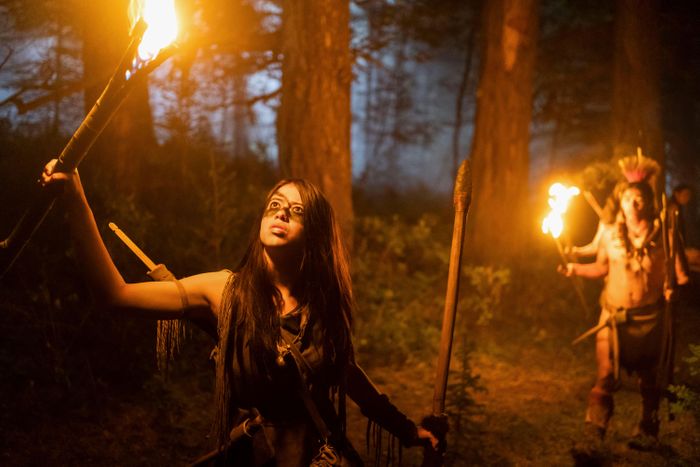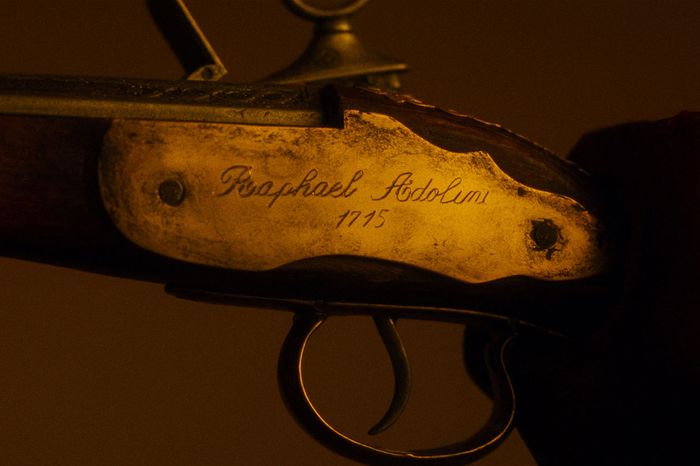
Dan Trachtenberg’s new Predator prequel, Prey, pulls off a rarity in today’s movie-franchise landscape: It avoids taking a torch to the series’s established continuity, while also sidestepping an overreliance on it. We do get a callback to the iconic line, “If it bleeds, we can kill it,” first uttered by Arnold Schwarzenegger in John McTiernan’s 1987 original. But for most of its running time, Prey sticks to its own hunting territory, setting its story in the Northern Great Plains in the early 18th century, where a young Comanche woman named Naru (Amber Midthunder) faces off against one of the intergalactic visitors who’ve been hunting humans for centuries. It isn’t until the very end of the film that we glimpse our first and only real Easter egg: a flintlock pistol engraved with the words Raphael Adolini 1715, hinting at an entire potential timeline leading up to 1990’s Predator 2.
In Prey, Naru escapes a party of Frenchmen who have set up hunting grounds on her lands. During her escape, she finds a pistol which she’s taught to use by one of the injured hunters. Once she returns to her tribe, bloody and triumphant after vanquishing the Predator, a close-up shot reveals that it’s the same weapon seen at the end of Predator 2, set 278 years later in the Los Angeles of 1997.
To recap, Predator 2 ends with the arrival of a group of Predators coming to collect their dead. Aboard their spaceship, just before they fly off, one of them throws the pistol to LAPD Lieutenant Mike Harrigan, played by Danny Glover, perhaps as a sign of respect. At the time, the gun was a revelation: It implied that the Predators had been hunting on Earth for many centuries, long before Dutch (Arnold Schwarzenegger) made what we previously believed was humanity’s first contact in Predator. Screenwriters Jim and John Thomas conceived the idea as a window to a possible prequel film that never came to fruition. But while Prey is the first movie to finally delve into that history, the Dark Horse comic books of the ’90s explored the Predators’ earlier hunts — and the history of that pistol, specifically.
The weapon’s backstory was fleshed out in the 1996 anniversary anthology issue A Decade of Dark Horse #1, in the story “Predator: 1718” by Henry Gilroy and Igor Kordey. The tale opens on Spanish pirate Captain Raphael Adolini, whose crew mutinies against him when he seeks to return stolen gold to the church for which it had been destined. As Adolini battles his crew, a nearby Predator keeps watch. And after the captain single-handedly kills all the mutinous pirates, the Predator decides he’s a worthy target, enters the battlefield, and prepares to face off against him. But before the alien hunter can challenge his newly chosen adversary, the Captain gets shot in the back by a bitter crew member still clinging to life. The Predator kills the dishonorable pirate, and with his dying breath, Adolini says, “Take it,” and bestows upon the Predator his engraved pistol.
Prey takes place in 1719, one year after Adolini’s demise, though it stops short of confirming the Dark Horse story as canon. Instead, it leaves us with a few big lingering questions. How did a Spanish pirate’s pistol end up in the hands of French hunters in America? Prey makes it clear that none of the Frenchmen had ever encountered a creature like the Predator before. If Adolini indeed gave the weapon to a Predator himself in this continuity, did that same Predator have another, later encounter with (possibly non-French) humans and lose it? And with the flintlock in Naru’s possession at the end of Prey, how does it make its way onto a Predator’s ship almost 300 years later?
There’s no real way to know — at least, not yet. But who’s to say we won’t someday meet the famed Adolini himself onscreen? Predators versus. pirates seems like too good an opportunity to pass up. The Prey franchise could even track this pistol throughout history’s multiple encounters between humans and Predators. Think of the possibilities: Predators versus samurai! Predators versus cowboys! Predators versus African Amazons! There’s no limit. Trachtenberg and screenwriter Patrick Aison have granted a means for Prey to become an anthology series that tests humanity’s resolve against the universe’s apex predators over our species’s history. That flintlock pistol may prove to be more than an Easter egg — it’s a treasure trove of storytelling potential.


